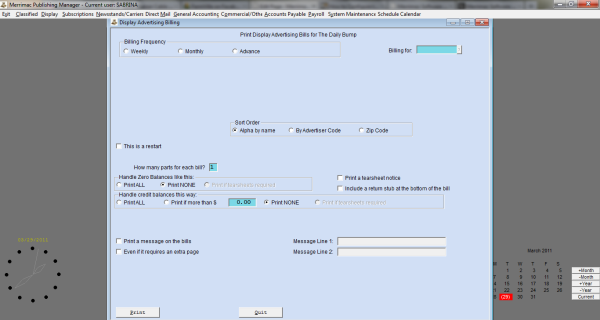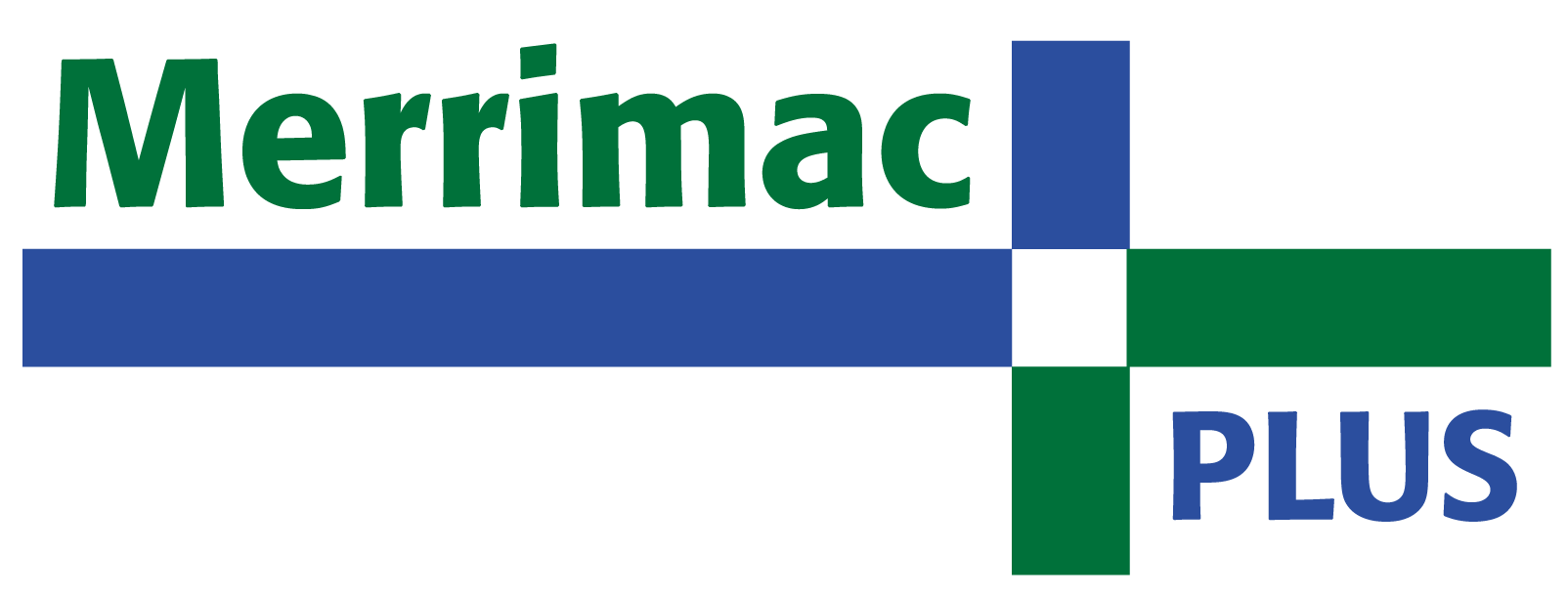
MerrimacPlus publishing manager offers a comprehensive data input and management program for all display advertising sales activity.
Display advertising is classified by size, type (display, classified, etc.), color, order source, and the section of the paper in which it will run. Orders are automatically credited to the appropriate sales rep. Up to one year’s worth of insertions can be entered as a single transaction. Several pricing and discounting schemes are available, including contract rates and earned frequency discounts. The system automatically calculates prices based on the type of ad and the advertiser’s contract status, but any price can be over-ridden by the operator for a single transaction.
All entries are checked for possible duplication and the operator is given the choice of canceling the previous entry, canceling the current entry, or allowing both entries to stand.
Two credit checks are performed, and the operator is alerted if a) the current entry brings the advertiser over a pre-assigned credit limit, or b) the advertiser has an outstanding balance more than X days old, where X is a limit assigned by the publisher. The privilege of over-riding either of these credit checks depends on the operator’s password level.
An optional copy status routine allows the user to create up to six status categories (“Copy In,” “Copy to Come,” “Pick Up”, etc.) and track the copy for each ad from the time that it’s entered until the issue goes to production.
New advertiser and agency records can be set up while using the order entry program, eliminating the need to exit and run one or more separate programs.
All invoices and statements contain a complete description of all current and past-due items. No lump-sum “Previous Balance” is ever shown. Items on which partial payment has been made show the total charge for the item followed by the date and amount of the payment(s) applied. Paid-in-full items are shown only if both the charge and the payment occurred in the same billing period, as in the case of a prepaid ad. Otherwise, no zero-balance invoices or statements are generated.
A late-payment service charge can be automatically added at the publisher’s option. Individual advertisers can be blocked from having the late charge added to their bills. Unpaid service charges appear on the advertiser’s record and on subsequent statements as separate line items, so they can be easily changed or canceled.
Advertisers who run on a trade-for-goods/services basis can be identified and their billing and receivables kept separate from cash advertisers’. Trade advertisers receive a statement each month showing their account status and clearly labeled “TRADE BALANCE – DO NOT PAY” or “TRADE CREDIT.” Trade revenue and receivables are kept in separate general ledger accounts from cash revenue and receivables.
Agency billing is automatic if specified in the advertiser’s record, and agency commission is calculated and deducted from the invoice. The commission rate can be set for each individual advertiser-agency relationship. (For example, many state press associations also act as agencies, usually at a rate higher than the standard 15%.)
Payment EntryThe MerrimacPlus payment entry feature allows the operator to apply payments to the oldest outstanding invoice(s) or to selected invoices. If the operator chooses to apply to selected invoices, a complete list of open invoices is displayed. Payment is recorded by type (check, cash, American Express, Mastercard or Visa) and a check number or card number and expiration date may be entered. Each payment entry is posted directly to the cash receipts journal.
The deposit log report prints a list of all payments received since the last time the log was printed, sorts payments by type, and shows an advertiser code and name for all payments. For payments received from an agency, the deposit log shows both agency and advertiser for whom payment was made.
The MerrimacPlus system allows cash to be withheld from the bank deposit and automatically credits these funds to the petty cash account, prints a summary of all general ledger debits and credits for the deposit, and shows a final total that should coincide with the actual bank deposit receipt. Running the deposit log report updates the MerrimacPlus system’s internal bank account balance. The program also allows reprinting of previous deposit logs.
Display advertising is classified by size, type (display, classified, etc.), color, order source, and the section of the paper in which it will run. Orders are automatically credited to the appropriate sales rep. Up to one year’s worth of insertions can be entered as a single transaction. Several pricing and discounting schemes are available, including contract rates and earned frequency discounts. The system automatically calculates prices based on the type of ad and the advertiser’s contract status, but any price can be over-ridden by the operator for a single transaction.
All entries are checked for possible duplication and the operator is given the choice of canceling the previous entry, canceling the current entry, or allowing both entries to stand.
Two credit checks are performed, and the operator is alerted if a) the current entry brings the advertiser over a pre-assigned credit limit, or b) the advertiser has an outstanding balance more than X days old, where X is a limit assigned by the publisher. The privilege of over-riding either of these credit checks depends on the operator’s password level.
An optional copy status routine allows the user to create up to six status categories (“Copy In,” “Copy to Come,” “Pick Up”, etc.) and track the copy for each ad from the time that it’s entered until the issue goes to production.
New advertiser and agency records can be set up while using the order entry program, eliminating the need to exit and run one or more separate programs.
Billing
Billing is generated automatically from display advertising orders entered. Advertisers can receive an invoice for every issue and a statement at the end of the month, or just one summary invoice/statement at the end of the month. This choice can be made individually for each advertiser. Monthly statements and invoice/statements show the aging of the account.All invoices and statements contain a complete description of all current and past-due items. No lump-sum “Previous Balance” is ever shown. Items on which partial payment has been made show the total charge for the item followed by the date and amount of the payment(s) applied. Paid-in-full items are shown only if both the charge and the payment occurred in the same billing period, as in the case of a prepaid ad. Otherwise, no zero-balance invoices or statements are generated.
A late-payment service charge can be automatically added at the publisher’s option. Individual advertisers can be blocked from having the late charge added to their bills. Unpaid service charges appear on the advertiser’s record and on subsequent statements as separate line items, so they can be easily changed or canceled.
Advertisers who run on a trade-for-goods/services basis can be identified and their billing and receivables kept separate from cash advertisers’. Trade advertisers receive a statement each month showing their account status and clearly labeled “TRADE BALANCE – DO NOT PAY” or “TRADE CREDIT.” Trade revenue and receivables are kept in separate general ledger accounts from cash revenue and receivables.
Agency billing is automatic if specified in the advertiser’s record, and agency commission is calculated and deducted from the invoice. The commission rate can be set for each individual advertiser-agency relationship. (For example, many state press associations also act as agencies, usually at a rate higher than the standard 15%.)
Adjustments and Corrections
Permits any billing or payment entry to be changed or canceled at any time. Charges or payments can be assigned to a different advertiser, corrected or canceled, and payment applications can be reassigned. All required accounting transactions through to the general ledger are handled automatically, and a corrected invoice or a debit or credit memo is generated if requested.Call Record System
The Call Record System allows the publisher to track sales reps’ activity related to specific accounts — either current advertisers or prospects. All sales calls can be logged and follow-up actions and dates specified.Sales Reports
There are a wide variety of reports available in the MerrimacPlus display advertising system, including:- Accounts Receivable
- Sales Reps’ Commission Report
- Advertiser Listing
- Daily Entry Log
- History Reports
- Reference Lists
- Monthly Closing Report
- Contract Exception Report
- Over Credit Limit Report
- Production and Copy Reports
- Sales Reports (including sales by issue, month, order source, salesperson, section, ad type, dollar volume, issue-by-issue, etc.)
- Tearsheet List
- Bad-Debt Write-Offs
- Contract Expiration Report
Payment Entry
The deposit log report prints a list of all payments received since the last time the log was printed, sorts payments by type, and shows an advertiser code and name for all payments. For payments received from an agency, the deposit log shows both agency and advertiser for whom payment was made.
The MerrimacPlus system allows cash to be withheld from the bank deposit and automatically credits these funds to the petty cash account, prints a summary of all general ledger debits and credits for the deposit, and shows a final total that should coincide with the actual bank deposit receipt. Running the deposit log report updates the MerrimacPlus system’s internal bank account balance. The program also allows reprinting of previous deposit logs.

